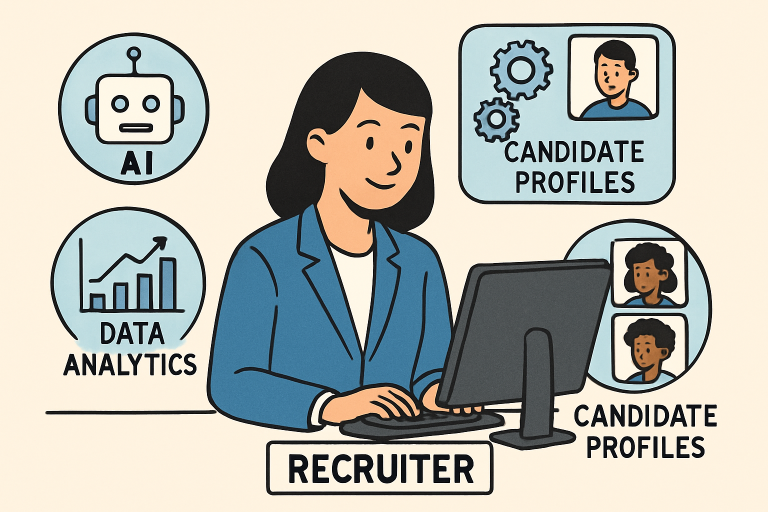Introduction
The workforce landscape is transforming rapidly as organizations strive to attract, engage, and retain the best talent in a competitive, fast-paced environment. Modern businesses are redefining their approach by adopting strategic and adaptive talent acquisition methods to address evolving market demands and workforce expectations. A forward-thinking talent and acquisition strategy helps companies secure top-tier candidates and fuel long-term organizational growth.
Strategic talent acquisition isn’t just about filling vacancies—it’s about employing cutting-edge solutions and data-backed techniques that identify individuals with the right skills, mindset, and cultural fit. By leveraging new technologies and prioritizing candidate potential, companies can build a robust pipeline of future leaders and innovators.
The shift toward digital-first, candidate-centered recruitment is also helping organizations respond quickly to changes in the job market while supporting diversity and inclusion. Today’s talent acquisition landscape demands speed, visibility, and fair evaluation—integral factors for creating a thriving, future-ready workforce.
As organizations recognize the importance of holistic recruitment strategies, they are increasingly focused on aligning their hiring processes with long-term business objectives and the dynamic needs of their industry. Leading companies are moving away from traditional methods, using actionable data and automation to optimize candidate experience and organizational outcomes.
Leveraging AI and Automation in Recruitment
Artificial intelligence and automation redefine how HR teams source, attract, and select candidates. AI-driven tools filter resumes, flag potential matches, and automate repetitive tasks—saving time and reducing human error. According to a recent Deloitte report, over 30% of companies use AI in at least one HR process, indicating the rapid adoption of intelligent hiring technologies.
These advancements enable organizations to analyze large volumes of candidate data at scale, surface hidden talent, and predict candidate success based on historical hiring patterns and performance analytics. Automation tools optimize communication, promptly notify candidates of application status, and allow recruiters to focus on building relationships and evaluating soft skills—a step critical for long-term retention and cultural fit.
As AI tools become more sophisticated, they can assess candidate experience beyond keywords and education, evaluating real-world competencies and soft skills through video interviews, gamified assessments, and social media profiles. This expansion of screening criteria helps organizations identify high-potential candidates that traditional processes might have overlooked.
Emphasizing Skills-Based Hiring
Companies leading in talent acquisition are pivoting from traditional “degree-first” hiring to skills-based recruitment. This evolution acknowledges that many in-demand job roles no longer require a specific degree but rather validated, job-related skills. By focusing on what a candidate can do versus what academic certificates they possess, organizations broaden their access to a more varied and frequently underutilized talent pool.
Tech giants like IBM and Google have championed this approach in recent years, eliminating four-year degree requirements for numerous job postings and instead relying on skills assessments, coding challenges, and portfolio reviews. The result is a more inclusive recruiting process that can tap into diverse backgrounds while identifying job-ready candidates from day one.
Skills-based hiring also considers the future, aligning the required skills for roles with shifting market trends and innovations. As new roles emerge and traditional roles evolve, prioritizing adaptability and technical proficiency enables organizations to remain resilient and agile.
Implementing Data-Driven Diversity and Inclusion Strategies
The increasing use of analytics in talent acquisition drives more intentional and effective diversity, equity, and inclusion (DEI) strategies. Companies that track representation across every hiring stage—sourcing, interviewing, and offers—gain deeper insight into where bias may exist and where improvement is needed. Data dashboards and DEI tracking tools allow HR leaders to measure progress and hold themselves accountable to organizational goals.
Incorporating data in DEI enables more comprehensive reporting to leadership, helping link recruitment results with overall business growth and employee satisfaction. Regularly reviewing hiring metrics—such as interview-to-offer ratios by demographic, candidate satisfaction surveys, and pay equity audits—ensures recruitment teams follow through on their DEI commitments. According to McKinsey & Company, organizations in the top quartile for ethnic and gender diversity are more likely to outperform their peers by up to 36% in profitability.
Leveraging such insights empowers organizations to continually fine-tune their practices, promote fairness, and craft a culture where every candidate and employee—regardless of background—can succeed and advance.
Integrating Technology for Enhanced Recruitment
Advanced recruitment technologies extend beyond applicant tracking systems (ATS), offering end-to-end solutions that boost efficiency and transparency throughout the hiring journey. AI-based platforms can now process candidate intent from application and communications data, automate scheduling, and streamline onboarding processes.
These platforms also enhance recruiter productivity by creating searchable talent repositories and providing real-time analytics on campaign effectiveness, time-to-hire, and source of hire. Candidate relationship management systems facilitate ongoing engagement, nurturing talent pipelines for future needs, and reducing the risk of losing high-potential candidates to competitors.
The candidate experience is also elevated—mobile-responsive applications, chatbots for FAQs, and instant feedback mechanisms foster a positive, modern applicant journey. In a competitive labor market, delivering a smooth and engaging experience from the first touchpoint to onboarding can significantly influence a candidate’s decision to accept an offer.
As organizations evaluate their future talent acquisition tech stack, integrating flexible, scalable tools remains key to staying ahead in the modern workforce landscape.
Final Thoughts
Adopting strategic talent acquisition techniques in a labor market defined by transformation and digital acceleration allows organizations to build robust, adaptable, and diverse teams. Embracing technologies like AI and automation, prioritizing skills-based hiring, and leveraging data-driven DEI initiatives will be critical for organizations seeking to outperform the competition and secure the best talent for long-term success.
